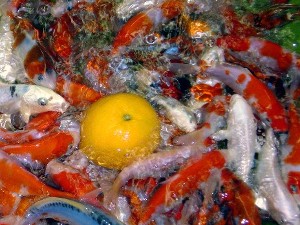
There are many factors to consider when feeding your Koi:
- Filter size
- Pond size
- Filter type and amount of time available to clean it
- How many Koi you have in your pond
- What season of the year it is
Most people generally feed their Koi 2-5 times a day. If you feed them around 2-3 times a day, they will grow slower or even stay around the same size. If you feed your Koi 3-5 times a day, they will grow fast and reach their maximum size sooner.
You do have to watch how much you feed your Koi; you don't want to overload your biological filter. If that happens, chances are your pond will have an Ammonia spike and that could possibly hurt or kill your Koi. Over-feeding your Koi can harm your Koi too. They can get obese and then suffer from the related health problems.
The more you feed your Koi, the more waste they will excrete. You'll need some way to remove the waste, or it will build up on the bottom of you pond. A good way to remove the fish waste is to install bottom drains and have them flow into your filter. You'll also need to take time each week to clean your filters, otherwise, the waste will build up in them and the water will start channeling through your filter material.
If you have a lot of Koi, you'll need a big pond and a big filter if you plan on feeding them a lot and growing them out. Most Koi usually grow to a couple feet in length, but if you have a Koi with a good bloodline, it could grow up to 3 feet long. Summertime is the grow out period for Koi. In a natural environment, a Koi will eat as much as it can during the summer in order build up fat to live off of in the winter when food in scarce. You should feed your Koi a food that is high in protein during the summer to boost their growth rates.
Koi can also be fed treats. Koi love oranges, grapefruit, lemons, watermelons, bread, earthworms, grubs and many other healthy fruits and vegetables. If you feed them treats once in a while, be sure to cut them in small pieces so your Koi will be able to eat them easily. Fruits like oranges and grapefruits can be halved and tossed into the water.
In the fall, when your pond temperature drops below 60 degrees Fahrenheit, you should start feeding your Koi a food that is high in wheat germ to help clean out their digestive system. When the water temperature starts dropping below 50 degrees Fahrenheit, you should stop feeding them altogether. When the water temperature gets that cold, your Koi's digestive system stops and any food that is left in them will start to rot their digestive tract.
In the winter, Koi do not eat at all. Their metabolism slows down to a crawl, so they only need their body fat to live off of during the cold months. In the spring, your Koi's metabolism will just be starting up, so it is a good idea to feed them an easily digestible food that is high in wheat germ. You can start feeding them once the water temperature in your pond is constantly above 50 degrees Fahrenheit. A good way to tell when to start feeding your Koi is by looking at the sides of you pond to see if they have been nibbling at the algae that grows on it. Start by feeding them once a day, and then gradually increase to the amount you will feed them during the summer. When the water temperature gets constantly about 60 degrees Fahrenheit, you can start feeding your Koi food that is high in protein.
A good Koi Food will have complete proteins. A good Koi Food will also have stabilized Vitamin C in it. Stabilized Vitamin C lasts for months before it breaks down, while regular Vitamin C has a maximum shelf life of 90 days.
It is not a good idea to feed Koi cheap catfish chows, they are usually made up of poor proteins and will fatten your Koi instead growing them out. Cheap catfish chows also tend to make a Koi's colors fade too.
Back to Koi Care.